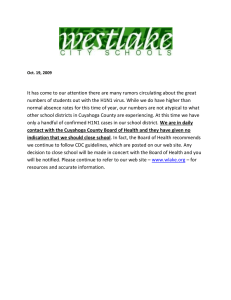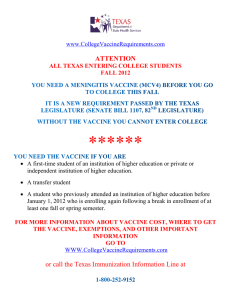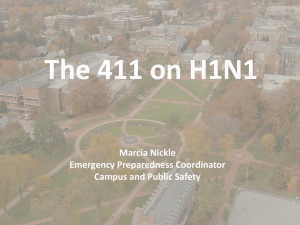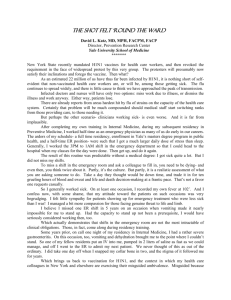H1N1 Outbreak: Lessons Learned and Preparation for the Next Pandemic
advertisement
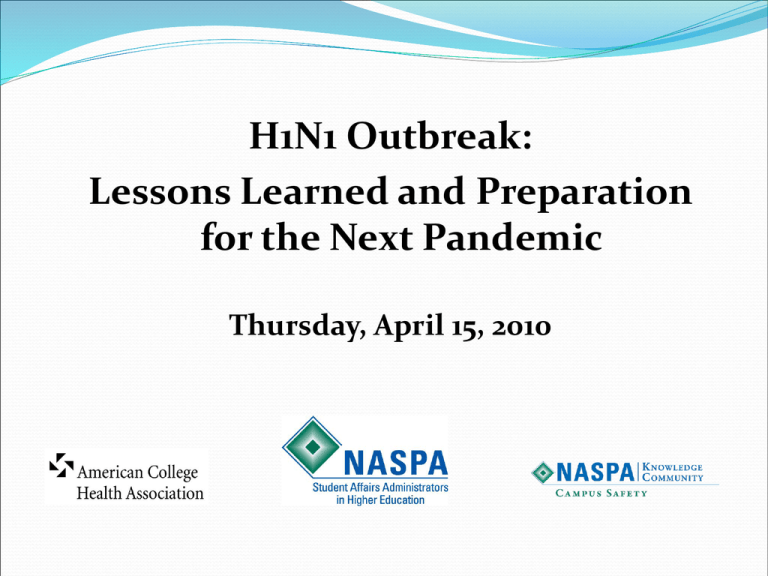
H1N1 Outbreak: Lessons Learned and Preparation for the Next Pandemic Thursday, April 15, 2010 Webinar Instructions Asking a Question You are welcome to type your question into the question box on the right-hand task bar at any time during the presentation. The presenters will take your questions during designated Q&A periods. If using the phone, make sure you’ve hit the audio pin. This number is labeled on the task bar on the right-hand side of your screen. The moderator can un-mute you when you do this and raise your virtual hand. Presenters Donna M. Barry, MSN, APN, FN-CSA, Nurse Practitioner and the Director of the University Health Center at Montclair State University Anita L. Barkin, Dr.P.H., M.S.N., C.R.N.P., Director of Carnegie Mellon University Student Health Services Michael Mardis, Ph.D., Dean of Students & Associate Vice President for Student Affairs at the University of Louisville Dennis K. Sullivan, Assistant Director of Environmental Health and Safety, University Emergency Manager and adjunct faculty in the University of Louisville School of Public Health and Information Sciences Outline H1N1 Activity International National College and University Regional Pre H1N1 Planning assumptions On point or not National Activity H1N1 is still circulating and seasonal flu is quiet Disease rates are lower than in the fall Causing more disease in the southeast Hospitalizations are due to H1N1 Statistics as of 4/3/2010 ~ 60 million Americans infected ~ 265,000 hospitalizations ~ 12,000 deaths 90% under the age of 65 (5 times higher than seen with seasonal flu) ~122 million doses of vaccine have been shipped Regional and Local Activity Regional Georgia, Alabama, South Carolina Local Arkansas, Louisiana, Mississippi, North Carolina, Tennessee, Virginia Hawai’i, New Mexico, Puerto Rico Georgia Increase in flu-related hospitalizations More than seen since October Adults with chronic illnesses like diabetes, heart disease Not immunized with H1N1 vaccine Virus has not changed Vaccine is effective What’s Next? Third wave remains uncertain Concern that disease among those unvaccinated with chronic illness will continue to cause unnecessary hospitalization and death Vaccine in fall with be trivalent Vaccinate now with H1N1 to protect until the fall vaccine is available Pre H1N1 Pandemic Influenza Planning Assumptions Will arrive with little warning, likely from overseas • Little time to act Simultaneous outbreaks throughout US The severity may not be immediately known Duration weeks to months Pre H1N1 Pandemic Influenza Planning Assumptions • Large numbers affected • Millions infected thus far • Disproportionately affecting the young • Decisions will be made on the basis of local conditions • Guidance from the CDC/WHO • Vaccine delayed • Will probably have vaccine by late fall Pre H1N1 Planning Assumptions High absenteeism Difficult to impossible to travel Disruptions and shortages of fuel, food stuffs, health care Antiviral agents in short supply Responding to the Second Wave • Less about campus evacuation and body bags • more about caring for ill students in the residential population • providing support for students living in the community • Developed new criteria for student life, academic and business decision making • Number of students, staff and faculty ill • Severity of illness Public Health Strategy Goes Live Slow down the spread in order to preserve resources (health care, critical services, supplies) Lessons Learned • Plan format should: Follow ICS response structure Identify leadership and roles before an incident Train all decision makers in ICS format Flow from institution’s Emergency Operations Plan Annex of overall EOP Same structure as all other EOP annexes Seamless coordination with outside agencies Lessons Learned • Unlink plan to WHO phases • All “outbreak” approach a.k.a. all-hazards • Plan needs to be adaptable to any level of public health incident • Flexibility with plan response is critical to success • Don’t plan on lead time • Virus hit quick and hard with both waves • Eliminate time frames expected to be ready for onset or next level of plan/response Lessons Learned Integrate “triggers” in plan that will determine next response action Disease extent What is its “acuity” level and risk factors to campus community? What is extent of campus “high risk” population and vulnerability to the disease? Disease severity How easy does it spread and can we contain it? Absentee rate Establish parameters that trigger when to close offices, cancel events, cancel classes, institute quarantine actions Lessons Learned • Expertise based • CDC and state health guidelines should be foundation for response • Direct link to public health emergency notice monitoring for campus health services • Development of expert based knowledge by health services administrators • Redundancy • Prevention • Response • Communication Lessons Learned Training drills/Tabletop exercises Critical to effective, knowledgeable response All player approach Isolation and Quarantine Multiple, effective mechanisms used Rely on fundamental health principles and institutional capabilities Lessons Learned Transparency of communication paid off Students, staff, parents, alumni all benefited Internal communications among ICS team External communications using multiple forms Academic Affairs response Stockpiling paid off Efforts devoted to prevention and response Shortages had strong impact on control of virus Lessons Learned Vaccination efforts Too much, too late Vaccine form made a difference in availability and student response The impact of YouTube and the media Lessons Learned “ Some things are in our control…. …and some things are not.” University of Louisville Emerging Disease Planning Groups Planning and Coordination Infection Control Policies and Procedures Point of Distribution Continuity of Student Learning Communications Planning Planning Groups developed objectives and they were adopted by Coordination Group Individual Groups consisted of a diverse group from the campus community Groups initially were to meet on a weekly basis, but that was pushed back due to a flash flood that damaged almost 80 buildings Isolation Strategies Employee medical certification for absence was suspended until further review Ill students were instructed to stay home Faculty were asked provide consideration for ill students Residential Life isolation Return home if within an hour Moving roommates Providing food service Prevention Strategies Education (Communications Strategy) Hand sanitizer Stockpiling supplies Vaccination Seasonal Flu vaccination H1N1 Vaccination Communication/Prevention Dedicated Website http://louisville.edu/update/flu/ Regular updates About H1N1 Tips for flu prevention Flu Shots at UofL Consent form online FAQ for students, faculty, and staff Links to CDC and Flu.gov Communication/Prevention Communication/Prevention Video from High Profile students Handbills with information and prevention Targeted emails to the selected populations students living on campus, health science students, parents Emails to the campus community Referring them to the website for more info Hand Sanitizer Provided (funded) mainly by the central Administration, but a number of units added units in their areas. (Res Life, Food Service) Purchased 800 mountable units and several thousand desktop/pocket bottles (.5-12 ounces) Provided an average of 100 containers weekly, costing $49k over 14 weeks Stockpiled Supplies Rubber gloves – 8,000 pairs (2k of each size) N-95 Masks – 6,000 Surgical Masks - 8,000 Disposable Gowns - 1,000 12 oz Hand Sanitizer - 200 Seasonal Vaccine Free to all students, faculty and staff; $5.00 for family members Administered 6,000 does Funded by Provost’s Office Previous year only administered 2,500 Administered Two campus health offices Vaccination day in each dorm 4 vaccination days at various locations Campus H1N1 Vaccinations Operated minipods Only cost was salaries HSC (healthcare) 600 doses (mixed), 120 minutes HSC (healthcare) 600 doses (mixed), 120 minutes Belknap (students) 600 doses (flumist), 240 minutes Belknap (anyone) 1,000 doses (mixed), 5 hours U of L’s Planning Fall Kick-off meeting was day before our Flood Vaccine distribution plan was joint effort by DEHS and SPHIS 2 MPH and an Engineering graduate students did much of the planning Immediately began developing plans to administer 30-50K doses of vaccine Local Health Department Did not have a plan in place for conducting a mass vaccination POD U of L had plans and logistics in place, ready to deliver vaccine to 30,000 Health Department asked the University for Help A two page MOU turned into a 17 page contract The Plan Hold a community-wide H1N1 mass immunization point of dispensing. H1N1 vaccines were administered via one of two methods: (1) a drive-thru or (2) a walk-up process. Injectable and intranasal vaccines were available. Vaccine recipients chose which method they preferred. Pod Results Total Hours of Operation – 19 Totals vaccinated – 19,079 Day 1 – 12,613 Day 2 – 6,466 Walkthru – 6,342 Drivethru – 12,737 Avg. 1004 vaccinations/hour Cost-effectiveness Overall cost was $13.35 per immunization administered. Costs were significantly higher for the walk-up method ($29.61/immunization administered) (Does not include public transportation costs) Drive-thru method($5.58/immunization administered) Results On average, the drive-thru strategy provided 400 additional immunization per hour (796 vs. 396). For 10 hours of the POD, about 50% of people handled in walk-up tent were “forced” to choose that option. The drive-thru strategy was the least expensive method and was the process of choice by more than 60% of the citizens coming to the event for immunization. Questions? Donna M. Barry, barryd@mail.montclair.edu Anita L. Barkin, ab4x@andrew.cmu.edu Michael Mardis, m.mardis@louisville.edu Dennis K. Sullivan, dksull01@gwise.louisville.edu
